#solanum dulcamara
Explore tagged Tumblr posts
Text
PSA, Deadly Nightshade is not a catch-all name for any Nightshade, it is the other common name of Atropa belladonna, the second being just Belladonna.
Also this is not Deadly Nightshade:
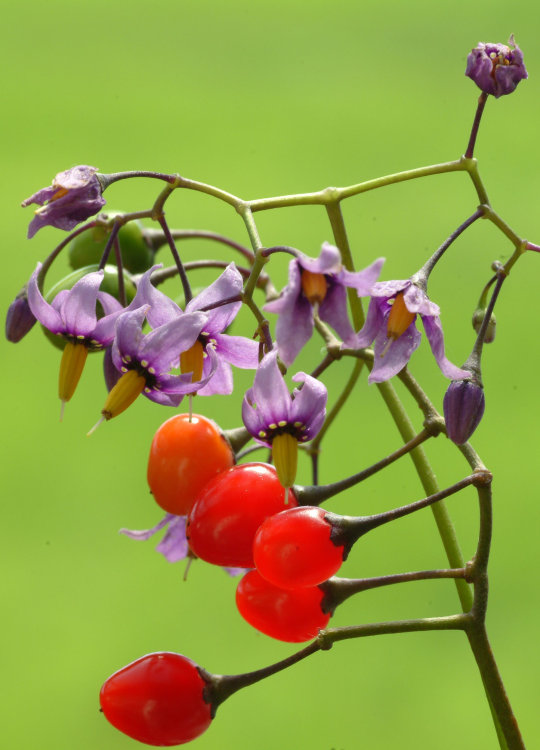
This is Bittersweet/Trailing/Woody Nightshade, also known as Snakeberry and by many other common names, scientific name Solanum dulcamara.
This is what Deadly Nightshade looks like:
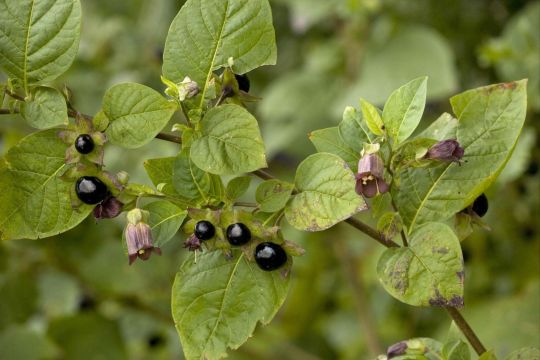

Maybe artist thought Bittersweet looked more striking, (personally I think Belladonna looks very dramatic) but somehow Bittersweet has been used for images of Deadly Nightshade. Which seems harmless in entertainment media and art, but now I've seen it on educational media and government websites, and this is where we run into trouble.
Draw whichever one you like for your art but maybe don't mix up labels for poisonous plants, because misidentification can kill.
#Belladonna#atropa belladonna#Deadly Nightshade#Bittersweet Nightshade#solanum dulcamara#plant identification#poisonous plants
8 notes
·
View notes
Text


ꕷꗞԸᕔᙁꚶᙏ ꕷᕔᙅɌꚶᙏ
HERBARIUM : Morelle douce-amère (Solanum Dulcamara)
LAPIDARIUM : Jaspe rouge, Malachite
LIEU DE CUEILLETTE : Abbaye d'Orval (Belgique)
#the crypt and the incubus#witch jewelry#electroformed jewelry#botanical jewelry#parure#pendentif#boucles d'oreilles#solanum dulcamara#morelle douce amère#malachite#jaspe#jaspe rouge
1 note
·
View note
Text
the minutiae of historical people's lives? yes!
the date I agreed to take a coworker's shift on my day off? CHECK THAT SHIT FIVE TIMES, MADAM, OR YOU'RE FORGETTING IT
movies where someone hears an important message only once and retains all the details….
girl if that were me, we’d be fucked. I have to reread emails like 4 times.
170K notes
·
View notes
Note
I’m here for your weirdest little guy, the most whacky little goofball you can provide. I haven’t decided if they’re going to become an oc or just some doodle motivation, but I have seen so many people get really pretty creatures so I am hoping to break that streak and get the freakiest freak you got! Dream goal would be if you pulled out something on the same level as a tailess whip scorpion, (if anyone is even slightly arachnophobic I would not look them up, they are like the “worst” parts of spiders cranked up to 11, otherwise definitely look them up they’re cool as hell)
That’s all I got, let’s test my luck!! Big money no Whammies!
String identified: ’ t tt g, t t ac tt ga ca . a’t c t’ gg t c a c t tat, t a a gt a tt cat a g t a tat ta a gt t at a gt! a ga t tg t a a a ta c, ( a gt aacc t t , t a t “t” at ca t , t t t t’ c a )
Tat’ a gt, t’ tt c!! g a!
Closest match: Solanum dulcamara genome assembly, chromosome: 12 Common name: Bittersweet nightshade

(image source)
#tumblr genetics#genetics#asks#requests#sent to me#justabeewithapen#plants#flowers#nightshade#bittersweet nightshade#our second nightshade! very cool
570 notes
·
View notes
Text
i kind of love how the outer wilds fandom managed to decide on one specific flower for solanum . cause solanum is not One plant its a quite diverse genus . goes all the way from regular ass tomatoes to belladonna. but we all collectively decided on solanum dulcamara . aka 'bittersweet nightshade' . cause this game really is bittersweet isn't it.
97 notes
·
View notes
Text
Bittersweet

Bittersweet (Solanum dulcamara) is a powerful plant associated with transformation, protection, and banishing. Its name reflects its dual nature, making it valuable in workings that require balance—whether between light and shadow, endings and beginnings, or love and sorrow. Witches use bittersweet to remove negative influences, break harmful cycles, and ward off unwanted energies by placing it near doorways or crafting protective sachets. It is also employed in spirit work and divination, enhancing intuition and bridging the gap between the seen and unseen. However, as a member of the nightshade family, bittersweet carries a potent, sometimes dangerous energy, demanding respect and careful handling. Whether used in spellwork for change, hex work, protection, or personal evolution, bittersweet reminds practitioners that all growth comes with both sweetness and struggle.
Toxicity Warning: Bittersweet is poisonous if ingested; caution is advised when handling.
Correspondences
• Common Names: Bittersweet Nightshade, Woody Nightshade, Dulcamara
• Element: Water, Fire
• Planet: Mercury, Saturn
• Zodiac: Gemini, Scorpio
• Deities: Hekate, Circe, Loki, Melinoe, Lilith
• Gender: Feminine
Properties
• Transformation & Change – Used in spells for personal growth, shedding the past, and navigating difficult transitions.
• Banishing Negativity – Wards off hexes, unwanted influences, and bad habits when placed in sachets or burned as incense (use dried leaves only in well-ventilated areas).
• Protection & Warding – Hung over doorways or windows, it repels ill intent and keeps negative forces away.
• Love and Attraction – In folk magic, bittersweet has been used to attract love while also ensuring protection from heartbreak.
• Dual Nature Workings – Its name, "bittersweet," symbolizes the balance of opposites, making it useful in shadow work, duality rituals, and reconciliations.
• Spirit Communication & Divination – Enhances intuition and facilitates connections with spirits or the unseen realms.
• Hexing & Binding – Useful in baneful magick and binding spells, blocks the target and steals their joy.

#bittersweet#herbalism#natural herbs#herbs#herbal#pray for me#witch#magick#satanic witch#lefthandpath#witchcraft#dark#witchblr#witch community#baneful witch#baneful magick#baneful#curses and hexes#hex#binding magick#binding#Duality#love spells#transformation#protection#poison path#toxic plants#nightshade#backyard#herbal magic
47 notes
·
View notes
Text

Solanum Dulcamara (Petandria Monogynia), 1775 by Mary Delany (1700-1788).
Collage of coloured papers, with bodycolour and watercolour, on black ink background (1776).
© The Trustees of the British Museum.
Creative Commons Attribution-NonCommercial-ShareAlike 4.0 International (CC BY-NC-SA 4.0) license.
69 notes
·
View notes
Text
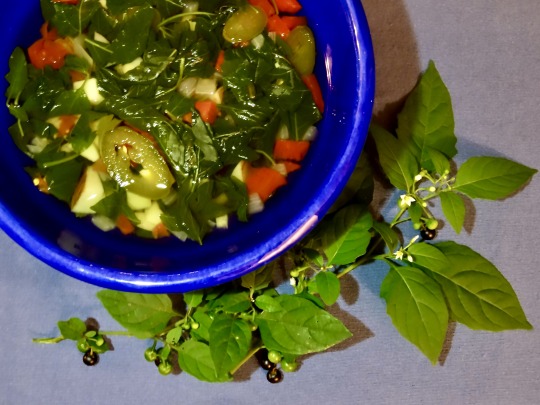
Sopa de mora salvadoreña (Salvadoran black nightshade soup)
American black nightshade (Solanum americanum)—not to be confused with bittersweet nightshade (Solanum dulcamara) or deadly nightshade (Atropa belladonna)—is a widespread flowering plant in the genus Solanum which grows throughout central America and Mexico, and into the northeastern United States. The genus Solanum, within the nightshade family Solanaceae, also includes tomatoes, potatoes, and eggplants.
The ripe berries of this plant, perhaps unsurprisingly, taste something like a very small tomato—but this dish concerns the plant's leaves. Sopa de mora is an earthy, savory, slightly spicy soup eaten in the countryside of El Salvador. It is made from the leaves of hierba mora, or black nightshade, in addition to squash, potato, chili, and sometimes chicken; a beaten egg or two may also be added and cooked, without stirring, directly in the soup.
A similar soup, made from black nightshade and broken pasta, is eaten in Guatemala under the name "caldo de quilete," "sopa de quilete," or "sopa de macuy." "Macuy" presumably derives from the word "majk'u'y", from Kaqchikel: a language in the Maya family spoken in central Guatemala.
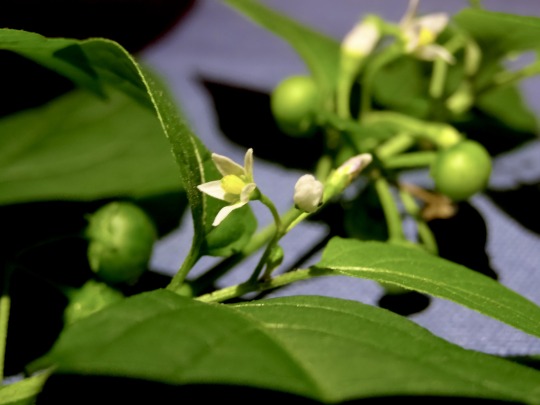
Recipe under the cut!
Patreon | Paypal | Venmo
Note that, despite the fact that black nightshade leaves are eaten all throughout the plant's native range, they contain varying amounts of toxic compounds including Solanine, and should be eaten in moderation. Avoid unripe (green) berries, and do not eat leaves raw. Some people advise pre-boiling the leaves and discarding the boiling water to remove toxins.
Ingredients:
Large bunch of American black nightshade (Solanum americanum), Eastern black nightshade (Solanum ptychanthum), or European black nightshade (Solanum nigrum) leaves, washed and chopped
1/2 white onion, diced
2 cloves garlic, chopped
1 tomato, diced
1 jalapeño, sliced
1 small russet potato, diced
1 chayote fruit (güisquil), diced (optional)
1 small carrot, sliced (optional)
Water or vegetable stock
I used water, and found that the vegetables and leaves gave the soup plenty of flavor; but it's not unusual to use vegetable or chicken stock.
Instructions:
Sauté onion and garlic on medium in a large stockpot until onions are softened and translucent.
Add garlic and sauté until light golden brown.
Add tomato and salt and sauté until softened and nearly dry.
Add remaining ingredients, plus water to cover. Boil until vegetables and leaves are softened, 15-20 minutes. Taste and adjust salt.
Identifying American black nightshade
These are quick notes rather than a complete guide. Don't forage unless you know what you're doing!
Leaves are alternate; ovate or lanceolate; with entire to undulate to blunty dentate margins. Flowers are about 1cm in diameter; white to light purple; with yellow stamens. Berries are green when unripe, and glossy and black when ripe. They grow in clusters. Calyxes are smaller than the berries, and curl away from them. Ripe berries, unripe berries, and flowers often appear on the same branch.
Avoid the green, unripe berries, which are toxic.

Lookalikes
Bittersweet nightshade (Solanum dulcamara) is poisonous. It has berries that are green when unripe, and bright red when ripe. Black nightshade has berries that are green when unripe, and black when ripe.
Deadly nightshade (Atropa belladonna) is poisonous. It has a calyx extending far beyond the berry, and the berries grow singly. Black nightshade has a calyx smaller than the berry, and its berries grow in clusters.
Eastern black nightshade (Solanum ptychanthum) is also in the Solanum nigrum complex and is sometimes considered synonymous with American black nightshade. It is edible, and may also be used in this recipe. Leaves are alternate; ovate or lanceolate. Leaf margins have 2-5 blunt teeth at the base, but become smooth and pointed at the tip. The base is rounded or cuneate (wedge-shaped). Petioles are winged with extensions of the leaf blade.
Flowers are about 1cm in diameter; white to light purple; with yellow stamens. Berries are green when unripe, and glossy and black when ripe; and grow in clusters.
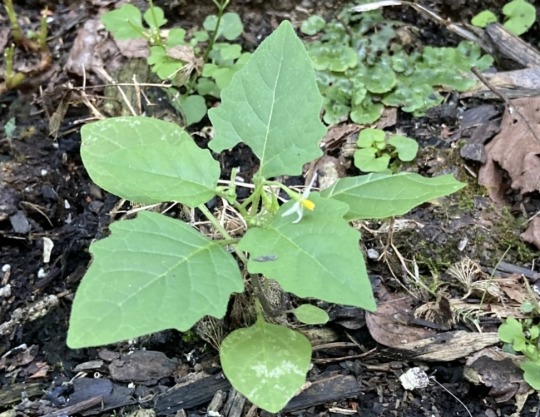
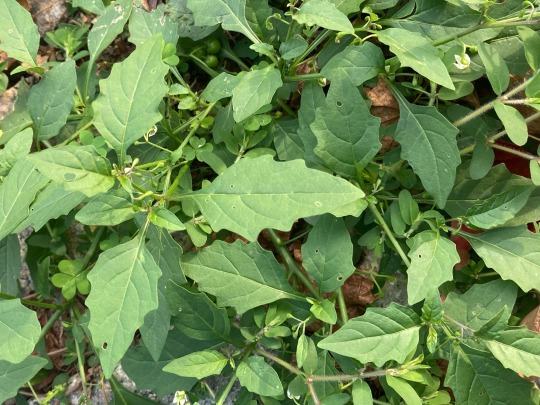
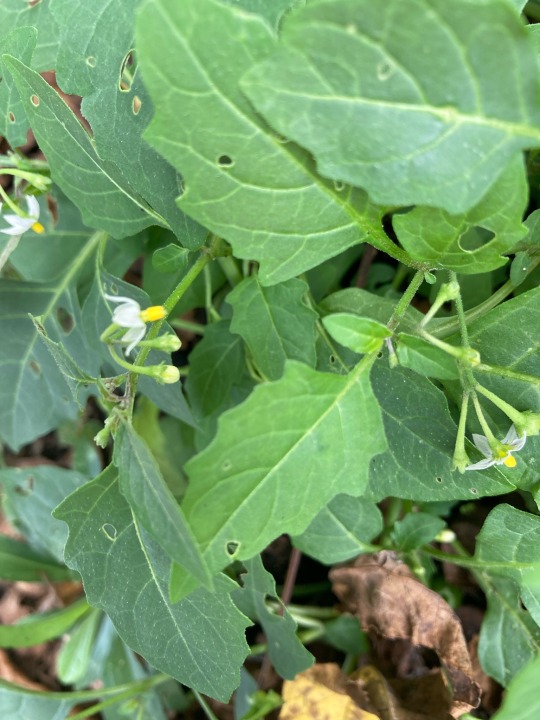
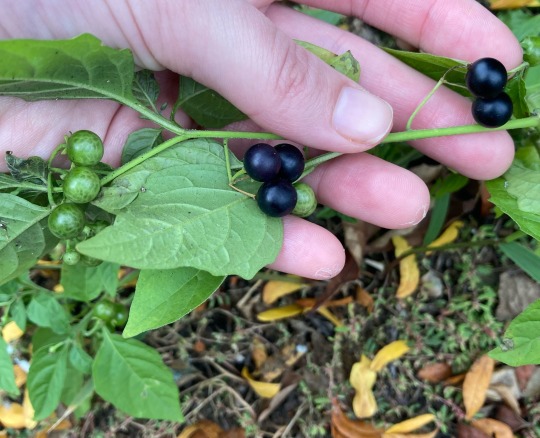
43 notes
·
View notes
Text
A little something from last month's explorations on Sauvie Island--a quick introduction on how to identify bittersweet nightshade (Solanum dulcamara).
#plants#botany#plant identification#nature identification#invasive species#invasive plants#Oregon#PNW#Pacific Northwest#nature#video#educational#foraging#poison#poisonous plants#Sauvie Island#hiking#outdoors
24 notes
·
View notes
Text

notes from op ; if you want to see more thoughts and one-off shitposts about rin specifically, you can check my #a.rin tag. tho it is barren atm. you might also just want to search rin in my blogs search
all characters written aged over the 18, usually early twenties.

—✮ LONG FIC [4k+]
✮ [ WON'T YOU LEND ME YOUR FAITH] | [SFW] | WC ; 21.4k
SYNOPSIS ; The love story of a sensitive, stoic soccer player and an eccentric wannabe journalist. Or that time you confess to itoshi rin, knowing he’ll reject you, and asking to befriend him in spite of it.
TAGS ; Fem + AFAB!Reader, Coming Of Age, Strangers To Friends To Lovers, Getting Together, Fluff, Shoujo Romance.
✮ [ SOLANUM DULCAMARA ] | [NSFW, 18+] | WC ; 5.1k
SYNOPSIS ; Rin is just so pretty when he cries.
TAGS ; AFAB + Fem!Reader, Established Relationship, PWP / Porn No Plot, Sub!Rin, Femdom!Reader, Mommy Kink, Dacryphilia, Penetrative Sex, Oral (F!Recieving)

—✮ SHORT FIC [1k+]
✮ [ POSITIONS ] | [NSFW, 18+] | WC ; 3.5k
SYNOPSIS ; You beg Rin to help you take references for sex positions as you work on a new doujinshi.
TAGS ;
note: this fic is part of the fujoverse, which is an au that exists on my blog. if u would like to see posts of that au, please click on the link.
✮ [ MEETING ] | [SFW] | WC ; 1.1k
SYNOPSIS ; You meet Rin's friends
TAGS ; Gender Neutral Reader, Established Relationship, Fluff
✮ [ PREMEDITATED ] | [NSFW, 18+] | WC ; 2.4k (FT. Isagi Yoichi)
SYNOPSIS ; Rin lets Isagi fuck you. Isagi likes seeing you squirm.
TAGS ; AFAB + Fem!Reader, Cucking, Soft Dom!Isagi, Voyeurism

—✮ BLURBS [-400]
ONE (NSFW) | TWO (NSFW) | THREE (NSFW)

40 notes
·
View notes
Text
Plants for The Eye
Aster (Aster)
Juniper (Juniperus)
Elderberry (Sambucus)
Oak (Quercus)
Sage (Salvia officinalis)
Rosemary (Salvia rosmarinus)
Sweet rocket (Hesperis matronalis)
White mulberry (Morus alba)
Bittersweet nightshade (Solanum dulcamara)
Ragged-robin (Silene flos-cuculi)
Eyebright (Euphrasia officinalis)
Ficus (Ficus retusa)
Japanese maple (Acer palmatum)
Peppermint (Mentha × piperita)
Basil (Ocimum basilicum)
Parsley (Petroselinum crispum)
Thyme (Thymus vulgaris)
Paper grass (Cyperus papyrus)
#og.txt#popculture magic#paganism#pop culture paganism#tma paganism#tma pcp#the magnus archives#tma#the eye#the ceaseless watcher#beholding
12 notes
·
View notes
Text
A Witch's Quick Guide to Bittersweet

With the leaves falling this bright red berry is easy to spot in wooded areas.
Name: American Bittersweet (Celastrus scandens) or Chinese Bittersweet (Celastrus orbiculatus). Please note that there are several plants called bittersweet in the nightshade family that I'm not referring to in this post.
Native Range: North America or China (depending on the species)
Identifying Traits: Bittersweet is a woody vine with 5 petaled, white, flowers and bright red fruits that can be seen in the late fall/ early winter. Each fruit has a 3 lobed capsule that opens when the fruit ripens. American Bittersweet has oranges capsules while Chinese Bittersweet has yellow.
Edible Parts: Warning! All Parts of these plants are toxic to people and pets.
Lookalikes: Bittersweet Nightshade (Solanum dulcamara) looks somewhat similar, but have larger, purple, flowers and the berries are eggshaped with no capsule over it.
Magical Properties: When gathered in silence the root can be used in wards against evil or malicious magic.
Some folklore states that if you bind a witch in bittersweet they will be unable to use their magic.
Wreaths can be made from the vines and hung in the home, particularly in windows and doors, for protection.
Other Important Info: American Bittersweet is considered to be a protected species and in the US it is illegal to harvest in some states. Chinese bittersweet is highly invasive and should not be planted outside of its native range, but can be harvested.
Always remember to do your research when identifying plants. If you're not sure, don't eat it!
#witchblr#witchcraft#witch tips#green witch#plant magic#paganism#Bittersweet#A Witch's Quick Guide Series
8 notes
·
View notes
Text
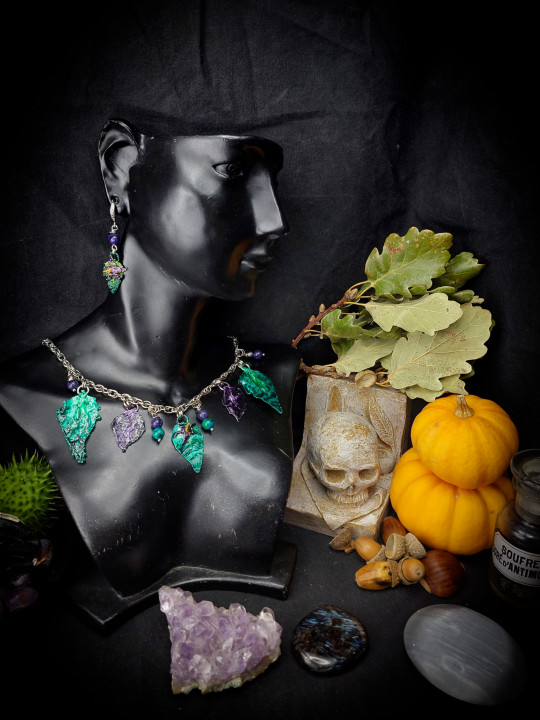
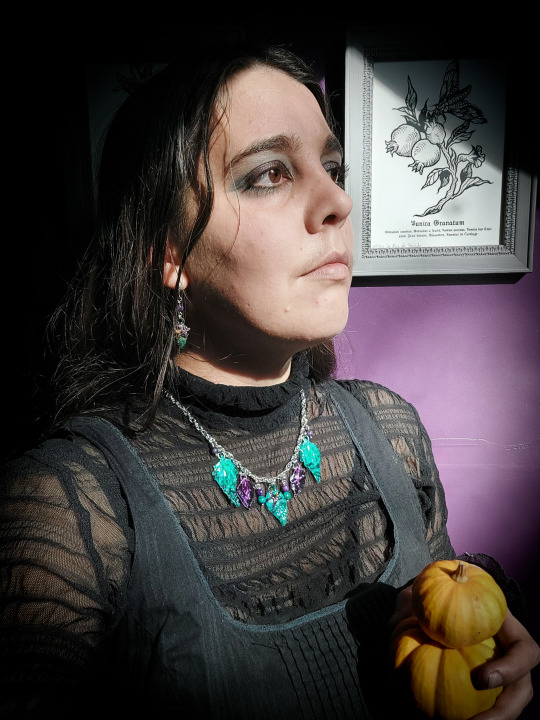
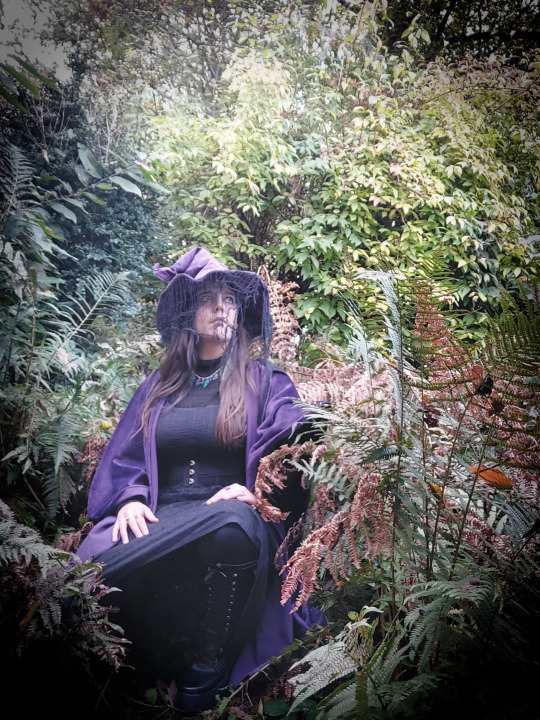
{{Disponible en boutique}}
- Ƈօʟʟɛƈȶɨօռ Ֆօʟǟռǟƈɛǟɛ -
ꕷꗞԸᕔᙁᕔᙅꗛᕔꗛ ꕷꗞԸᕔᙁꚶᙏ
HERBARIUM : Morelle douce-amère (Solanum Dulcamara), Morelle noire (Solanum Nigrum)
LAPIDARIUM : Charoïte, Chrysocolle
LIEU DE CUEILLETTE : Autun, Vézelay (Bourgogne)
#the crypt and the incubus#witch jewelry#electroformed jewelry#botanical jewelry#collier#solanaceae#solanum nigrum#morelle noire#solanum dulcamara#morelle douce amère#charoite#chrysocolle
1 note
·
View note
Note
⭐️⭐️⭐️☎👂
⭐️ for a headcanon about our muses. ⎛ x 3 ⎠
balduran thinks cecil is! very attractive, in the way he found belynne stelmane attractive. cecil is clever and obviously is more than just a pretty face- a deadly assassin who heads the chorus, which balduran is now working for,
which means that there's a lot of ... projecting there. balduran fucked shit up badly with belynne and so he's faced with another clever, morally not really the best, elegant person and he's like oh! ok! i can do this the right way!
he absolutely would love to take cecil on more dates.
☎ for cecil's info in balduran's phone (name, ringtone, picture, last text received/sent).
⎛ bold of you to assume balduran makes good use of the phone he got in spirale lmao ⎠
anyway cecil is listed as "dulcamara" which comes from solanum dulcamara the bittersweet nightshade, which is not the same as the belladonna, but it is in fact also poisonous- and also beautiful! balduran's more spot on with this than he thinks lmao. he's got a rather candid photo of cecil at the beach at golden ward, laughing- he looks adorable! ... balduran keeps the phone on silent because he is either doing The Job or he's adventuring and a phone randomly ringing gives him away.
❲ to 'dulcamara': while on the business trip to fibonacci, i decided to take a look at some of their galleries. some of the art is quite lovely. i know that you aren't fond of the place, so i picked up a painting for you. perhaps you can hang it on the wall of your home? ❳ ⎛ attached is a photo of a lovely classical painting, it seems to have been inspired by some romantic myth of gods and nymphs. like a painting that would be hanging on the walls of the castle ⎠
- business meeting, of course, meant he'd found his mark and finished the job...
👂 to overhear my muse talking about yours.
❝ yes, of course i've been to faucher lace, ❞ balduran's quite popular at the cafes in archimedes. a handsome adventurer, tall with wavy brown hair and pale green eyes- he's the stuff of rather raunchy romance novels, and he knows it. that's why he comes to the cafes, to be adored. but this time, the others are telling him about a lovely little boutique, saying he should be a model. ❝ cecil really is creative, isn't he? and he has other talented designers who work with him. he picks the best people to show off the work he does- i may not have the right sort of elegance for it- ❞
"oh, but you're so handsome!" says a young woman with a dreamy sigh, and balduran smiles. he knows, of course. ❝ there are many other lovely models who, i think, are more suited to show off cecil's work. but, it doesn't mean that i can't find time to spend with him. ❞ at this, there's a gasp from another young individual, much like the others, vying for balduran's attention- "so ... are you two ... lovers of some sort?"
balduran laughs, a warm sound that has his fans swooning- ❝ well, would it be exciting if i was his lover? sometimes i wonder how deep the interest runs, but i also quite cherish the bond we have as it is. i wouldn't wish to ruin it by overstepping boundaries- ❞
and that's true. cecil is a beautiful young man, but balduran still has days where he looks at cecil and sees belynne and desperately wants to be drowned in kisses.
#allswell#today on balduran has fans everywhere and all the talking asks are drabbles#we have this!!!
2 notes
·
View notes
Text
Oh @monarchofthequeerpotatoes:

I offer thou this, a hastily made 11pm photoshop rendering of my proposal for the Potato Kingdom flag
Symbolisms under the cut:
Main flag design: based on the bisexual flag (cause why not) with a crest/coat of arms in the centre like the flag of Portugal
Colours: main three are taken directly from the three most common colours of a potato (reddish, dark purple, and yellow) with the in-between lines being the monarch’s favourite colours (light blue and gold)
Halo: based loosely off of Christian halos from medieval Christian art and Dharma wheels/Dharmachakra (the holiness and perfection that is the kingdom)
Ears: rabbit and sheep ears, two animals that live off of the potatoes for survival
Nightshade flowers: potatoes belong to the Solanum family, often generally referred to as nightshades after Solanum Dulcamara
Infinity sign: both neurodivergence and the eternal reign of the monarch
Potato: potato :)
#I am well aware it is somewhat shoddily done however it is almost midnight where I live and#I am much too tired to do anything overly complex sorry
3 notes
·
View notes
Text

Not related to Atropa belladonna, bitter nightshade (Solanum dulcamara) contains solanine, the same toxin found in deadly nightshade.


#bitter nightshade#nature#photographers on tumblr#original photography on tumblr#pnw#flowers#green#violet#nightshade#poison#forbidden beauty#plants
2 notes
·
View notes